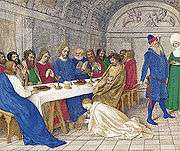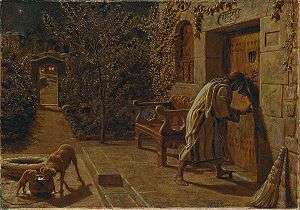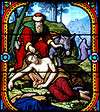Parables of Jesus
| Events in the |
| Life of Jesus according to the Gospels |
|---|
 |
|
In rest of the NT |
|
Portals: |
The Parables of Jesus can be found in all the canonical gospels, and in some of the non-canonical gospels, but are located mainly within the three synoptic gospels. They represent a key part of the teachings of Jesus, forming approximately one third of his recorded teachings. Christians place high emphasis on these parables; since they are the purported words of Jesus, they are believed to be what the Father has taught, indicated by John 8:28 and 14:10.[1][2]
Jesus' parables are seemingly simple and memorable stories, often with imagery, and all convey messages. Scholars have commented that although these parables seem simple, the messages they convey are deep, and central to the teachings of Jesus. Christian authors view them not as mere similitudes which serve the purpose of illustration, but as internal analogies in which nature becomes a witness for the spiritual world.[3][4]
Many of Jesus' parables refer to simple everyday things, such as a woman baking bread (parable of the Leaven), a man knocking on his neighbor's door at night (parable of the Friend at Night), or the aftermath of a roadside mugging (parable of the Good Samaritan); yet they deal with major religious themes, such as the growth of the Kingdom of God, the importance of prayer, and the meaning of love.
In Western civilization, these parables formed the prototype for the term parable and in the modern age, even among those who know little of the Bible, the parables of Jesus remain some of the best known stories in the world.[5]
Roots and sources
As a translation of the Hebrew word מָשָׁל mashal, the word "parable" can also refer to a riddle. In all times in their history the Jews were familiar with teaching by means of parables and a number of parables also exist in the Old Testament. The use of parables by Jesus was hence a natural teaching method that fit into the tradition of his time.[5][6] The parables of Jesus have been quoted, taught, and discussed since the very beginnings of Christianity.
Nature of parables of Christ
Parables are one of the many literary forms in the Bible, but are especially seen in the gospels of the New Testament. Parables are generally considered to be short stories such as the Good Samaritan, and which are differentiated from metaphorical statements such as, "You are the salt of the earth." A true parable may be regarded as an extended simile (Blomberg, C. L., Interpreting the Parables). Although some suggest parables are essentially extended allegories, others emphatically argue the opposite.[7] Dr. Kenneth Boa states that "Parables are extended figures of comparison that often use short stories to teach a truth or answer a question. While the story in a parable is not historical, it is true to life, not a fairy tale. As a form of oral literature, the parable exploits realistic situations but makes effective use of the imagination...Some of the parables [of Christ] were designed to reveal mysteries to those on the inside and to conceal the truth to those on the outside who would not hear."[8]
Canonical gospels
The three synoptic gospels contain the parables of Jesus. There are a growing number of scholars, who also find parables in the Gospel of John, such as the little stories of the Good Shepherd (John 10:1-5) or the childbearing woman (John 16:21).[9] Otherwise, it includes allegories but no parables. Several authors such as Barbara Reid, Arland Hultgren or Donald Griggs comment that "parables are noticeably absent from the Gospel of John".[10][11][12][13]
The Catholic Encyclopedia states: "There are no parables in St. John's Gospel. In the Synoptics ... we reckon thirty-three in all; but some have raised the number even to sixty, by including proverbial expressions."[14] The Gospel of Luke contains both the largest total number of parables (24) and eighteen unique parables; the Gospel of Matthew contains 23 parables of which eleven are unique; and the Gospel of Mark contains eight parables of which two are unique.
In Harmony of the Gospels, Cox and Easley provide a Gospel harmony for the parables based on the following counts: Only in Matthew: 11, only in Mark: 2, only in Luke: 18, Matthew and Luke: 4, Matthew, Mark and Luke: 6. They list no parables for the Gospel of John.[15]
Other documents
Parables attributed to Jesus are also found in other documents apart from the Bible. Some of these overlap those in the canonical gospels and some are not part of the Bible. The non-canonical Gospel of Thomas contains up to fifteen parables, eleven of which have parallels in the four canonical Gospels. The unknown author of the Gospel of Thomas did not have a special word for "parable," making it difficult to know what he considered a parable.[16] Those unique to Thomas include the Parable of the Assassin and the Parable of the Empty Jar.
The noncanonical Apocryphon of James also contains three unique parables attributed to Jesus.[17] They are known as "The Parable of the Ear of Grain", "The Parable of the Grain of Wheat", and "The Parable of the Date-Palm Shoot".[18]
The hypothetical Q document is seen as a source for some of the parables in Matthew, Luke, and Thomas.[19]
Purpose and motive
In the Gospel of Matthew (13:10–17) Jesus provides an answer when asked about his use of parables:[20]
The disciples came to him and asked, "Why do you speak to the people in parables?" He replied,
"The knowledge of the secrets of the kingdom of heaven has been given to you, but not to them. Whoever has will be given more, and he will have an abundance. Whoever does not have, even what he has will be taken from him. This is why I speak to them in parables:
Though seeing, they do not see; though hearing, they do not hear or understand."
While Mark 4:33–34 and Matthew 13:34–35 may suggest that Jesus would only speak to the "crowds" in parables, while in private explaining everything to his disciples, modern scholars do not support the private explanations argument and surmise that Jesus used parables as a teaching method.[21] Dwight Pentecost suggests that given that Jesus often preached to a mixed audience of believers and non-believers, he used parables to reveal the truth to some, but hide it from others.[1]
Christian author Ashton Axenden suggests that Jesus constructed his parables based on his divine knowledge of how man can be taught:[22]
This was a mode of teaching, which our blessed Lord seemed to take special delight in employing. And we may be quite sure, that as "He knew what was in man" better than we know, He would not have taught by Parables, if He had not felt that this was the kind of teaching best suited to our wants.
In the 19th century, Lisco and Fairbairn stated that in the parables of Jesus, "the image borrowed from the visible world is accompanied by a truth from the invisible (spiritual) world" and that the parables of Jesus are not "mere similitudes which serve the purpose of illustration, but are internal analogies where nature becomes a witness for the spiritual world".[3]
Similarly, in the 20th century, calling a parable "an earthly story with a heavenly meaning",[23] William Barclay states that the parables of Jesus use familiar examples to lead men's minds towards heavenly concepts. He suggests that Jesus did not form his parables merely as analogies but based on an "inward affinity between the natural and the spiritual order."[23]
Themes
A number of parables which are adjacent in one or more gospels have similar themes. The parable of the Leaven follows the parable of the Mustard Seed in Matthew and Luke, and shares the theme of the Kingdom of Heaven growing from small beginnings.[24] The parable of the Hidden Treasure and parable of the Pearl form a pair illustrating the great value of the Kingdom of Heaven, and the need for action in attaining it.[25]
The parables of the Lost Sheep, Lost Coin, and Lost (Prodigal) Son form a trio in Luke dealing with loss and redemption.[26]
The parable of the Faithful Servant and parable of the Ten Virgins, adjacent in Matthew, involve waiting for a bridegroom, and have an eschatological theme: be prepared for the day of reckoning.[27] The parable of the Tares[28] the parable of the Rich Fool,[29] the parable of the budding fig tree,[30] and the parable of the barren fig tree[31] also have eschatological themes.
Other parables stand alone, such as the parable of the unforgiving servant, dealing with forgiveness;[32] the parable of the Good Samaritan, dealing with practical love;[33] and the parable of the Friend at Night, dealing with persistence in prayer.[34]
Parables of the Kingdom of Heaven: hearing, seeking and growing
| Sower | Hidden Treasure | Pearl | Growing Seed | Mustard Seed | Leaven |
Parables of loss and redemption
| Lost Sheep | Lost Coin | Prodigal (Lost) Son |
Parables about love and forgiveness
 | ||
| Good Samaritan | Two Debtors | Unforgiving Servant |
Parables about prayer
| Friend at Night | Unjust Judge | Pharisee & Publican |
Eschatological parables
 |
|||||
| Faithful Servant | Ten Virgins | Great Banquet | Rich Fool | Wicked Husbandmen | Tares |
 |
|||||
| The Net | Budding Fig Tree | Barren Fig Tree |
Other parables
| Wise & Foolish Builders | Lamp under a Bushel | Unjust Steward | Rich Man and Lazarus | Talents (Minas) | Workers in the Vineyard |
Art
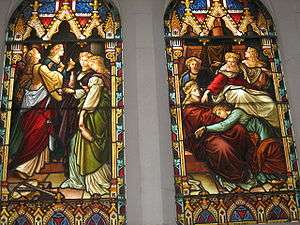
Of the thirty or so parables in the canonical Gospels, four were shown in medieval art almost to the exclusion of the others, but not mixed in with the narrative scenes of the Life of Christ. These were: the Ten Virgins, the Rich man and Lazarus, the Prodigal Son and the Good Samaritan.[35] Artists famous for depicting parables include Martin Schongauer, Pieter the Elder Bruegal and Albrecht Dürer. The Workers in the Vineyard also appears in Early Medieval works. From the Renaissance the numbers shown widened slightly, and the various scenes of the Prodigal Son became the clear favorite, with the Good Samaritan also popular. Albrecht Dürer made a famous engraving of the Prodigal Son amongst the pigs (1496), a popular subject in the Northern Renaissance, and Rembrandt depicted the story several times, although at least one of his works, The Prodigal Son in the Tavern, a portrait of himself as the Son, revelling with his wife, is like many artists' depictions, a way of dignifying a genre tavern scene. His late Return of the Prodigal Son (Hermitage Museum, St Petersburg) is one of his most popular works.
Poetry and hymns
As well as being depicted in art and discussed in prose, a number of parables form the inspiration for religious poetry and hymns. For example, the hymn "The Ninety and Nine" by Elizabeth C. Clephane (1868) is inspired by the parable of the Lost Sheep:
There were ninety and nine that safely lay
In the shelter of the fold.
But one was out on the hills away,
Far off from the gates of gold.
Away on the mountains wild and bare.
Away from the tender Shepherd’s care.
Away from the tender Shepherd’s care.[1]
Similarly, "My Hope Is Built" (Edward Mote, c. 1834) is inspired by the parable of the Wise and the Foolish Builders, and "How Kind the Good Samaritan" (John Newton, c. 1779) is inspired by the parable of the Good Samaritan.
Harmony of parables
A sample Gospel harmony for the parables based on the list of key episodes in the Canonical Gospels is presented in the table below. For the sake of consistency, this table is automatically sub-selected from the main harmony table in the Gospel harmony article, based on the list of key episodes in the Canonical Gospels. Usually, no parables are associated with the Gospel of John, just allegories.[15]
Parallels outside the canonical gospels
A number of parables have parallels in non-canonical gospels, the Didache, and the letters of Apostolic Fathers. However, given that the non-canonical gospels generally have no time sequence, this table is not a Gospel harmony.
See also
- Chronology of Jesus
- Gospel harmony
- Jesus in Christianity
- Life of Jesus in the New Testament
- Ministry of Jesus
- Miracles of Jesus
References
- 1 2 J. Dwight Pentecost, 1998 The parables of Jesus: lessons in life from the Master Teacher ISBN 0-8254-3458-0 page 10
- ↑ Eric Francis Osborn, 1993 The emergence of Christian theology ISBN 0-521-43078-X page 98
- 1 2 Friedrich Gustave Lisco 1850 The Parables of Jesus Daniels and Smith Publishers, Philadelphia pages 9–11
- ↑ Ashton Oxenden, 1864 The parables of our Lord William Macintosh Publishers, London, page 6
- 1 2 William Barclay, 1999 The Parables of Jesus ISBN 0-664-25828-X page 9
- ↑ Pheme Perkins, 2007 Introduction to the synoptic gospels ISBN 0-8028-1770-X page 105
- ↑ Kulikovsky, Andrew S. "The Interpretation of Parables, Allegories and Types". Biblical Hermeneutics. Retrieved 25 September 2015.
- ↑ Boa, Kenneth. "Literary Forms in the Bible". Bible.org. Bible.org. Retrieved 25 September 2015.
- ↑ See, for instance, Ruben Zimmermann, Puzzling the Parables of Jesus, Methods and Interpretation, Fortress, Minneapolis, 2015, 333-360; see the German-For-Neutestamentler-BLOG The Vine and the Branches by David Tryon, as others have throughout history including John Calvin in John Calvin's Commentary on John Volume 2
- ↑ Barbara Reid, 2001 Parables for Preachers ISBN 0-8146-2550-9 page 3
- ↑ Arland J. Hultgren, 2002 The Parables of Jesus ISBN 0-8028-6077-X page 2
- ↑ Donald L. Griggs, 2003 The Bible from scratch ISBN 0-664-22577-2 page 52
- ↑ According to the Catholic Encyclopedia article on Parables: "There are no parables in St. John's Gospel" and the Encyclopædia Britannica article on Gospel of St. John: "Here Jesus' teaching contains no parables and but three allegories, the Synoptists present it as parabolic through and through."
- ↑ "Catholic Encyclopedia: Parables". Retrieved 2008-02-16.
- 1 2 Steven L. Cox, Kendell H Easley, 2007 Harmony of the Gospels ISBN 0-8054-9444-8 page 348
- ↑ Scott, Bernard Brandon (1989). Hear Then the Parable: A Commentary on the Parables of Jesus. Minneapolis: Fortress Press, 33–34. The actual number of parables in Thomas is fluid. John Dominic Crossan counts 15, Ron Cameron 14, and Bernard Brandon Scott 13. See also Crossan, John Dominic (1992). In Parables: The Challenge of the Historical Jesus. Sonoma, CA: Polebridge Press and Cameron, Ron (1986). Parable and Interpretation in the Gospel of Thomas. Forum 2/2.
- ↑ Koester, Helmut (1990). Ancient Christian Gospels: Their History And Development. Philadelphia, USA: Trinity Press International. pp. 196–200.
- ↑ Cameron, Ron (2004). Sayings Traditions in the Apocryphon Of James. Cambridge, MA: Harvard Divinity School, 8–30.
- ↑ Theissen and Merz 1996, p.339
- ↑ Matthew 13:10–17. See also Mark 4:10–12 and Luke 8:9–10
- ↑ Harris, Stephen L., Understanding the Bible. Palo Alto: Mayfield. 1985.
- ↑ Ashton Oxenden, 1864 The parables of our Lord William Macintosh Publishers, London page 1
- 1 2 William Barclay, 1999 The Parables of Jesus ISBN 0-664-25828-X pages 12.
- ↑ Ben Witherington, Women in the Ministry of Jesus: A study of Jesus' attitudes to women and their roles as reflected in his earthly life, Cambridge University Press, 1987, ISBN 0-521-34781-5, p. 40–41.
- ↑ John Nolland, The Gospel of Matthew: A commentary on the Greek text, Eerdmans, 2005, ISBN 0-8028-2389-0, pp. 565–566.
- ↑ Richard N. Longenecker, The Challenge of Jesus' Parables, Eerdmans, 2000, ISBN 0-8028-4638-6, pp. 201–204.
- ↑ R. T. France, The Gospel According to Matthew: An introduction and commentary, Eerdmans, 1985, ISBN 0-8028-0063-7, pp. 348–352.
- ↑ R. T. France, The Gospel According to Matthew: An introduction and commentary, Eerdmans, 1985, ISBN 0-8028-0063-7, p. 225.
- ↑ John Clifford Purdy, Parables at Work, Westminster John Knox Press, 1986, ISBN 0-664-24640-0, pp. 41–43.
- ↑ Bernard Brandon Scott, Hear Then the Parable: A commentary on the parables of Jesus, Fortress Press, 1989, ISBN 0-8006-2481-5, pp. 338–340.
- ↑ Peter Rhea Jones, Studying the Parables of Jesus, Smyth & Helwys, 1999, ISBN 1-57312-167-3, pp. 123–133.
- ↑ Craig S. Keener, A Commentary on the Gospel of Matthew, Eerdmans, 1999, ISBN 0-8028-3821-9, pp. 456–461.
- ↑ Joel B. Green, The Gospel of Luke, Eerdmans, 1997, ISBN 0-8028-2315-7, p. 432.
- ↑ I. Howard Marshall, The Gospel of Luke: A commentary on the Greek text, Eerdmans, 1978, ISBN 0-8028-3512-0, pp. 462–465.
- ↑ Emile Mâle, The Gothic Image: Religious Art in France of the Thirteenth Century, p 195, English trans of 3rd ed, 1913, Collins, London (and many other editions), ISBN 978-0064300322
- ↑ Butts, James R.; Funk, Robert Walter; Scott, Bernard Brandon (1988). The parables of Jesus: red letter edition: a report of the Jesus Seminar. Sonoma, Calif: Polebridge Press. pp. 74–75. ISBN 0-944344-07-0.
- ↑ Throckmorton, Burton Hamilton (1992). Gospel parallels: a comparison of the synoptic gospels: with alternative readings from the manuscripts and noncanonical parallels. Nashville: T. Nelson. pp. xxx–xxxi. ISBN 0-8407-7484-2.
- ↑ Hultgren, Arland J. (2000). The parables of Jesus: a commentary. Grand Rapids, Mich: Eerdmans. ISBN 0-8028-6077-X.
Further reading
- C. H. Dodd, The Parables of the Kingdom ISBN 002330460X.
- Barclay, William, 1999. The Parables of Jesus ISBN 0-664-25828-X
- Gowler, David B., 2000. What Are They Saying About the Parables? Mahweh, NJ: Paulist Press. ISBN 978-0809139620
- Joachim Jeremias, The Parables of Jesus ISBN 0334029171.
- Lisco, Friedrich Gustav and Fairbairn, Patrick, 1850. The Parables of Jesus Daniels and Smith Publishers, Philadelphia
- Pentecost, J. Dwight, 1998. The parables of Jesus: lessons in life from the Master Teacher ISBN 0-8254-3458-0
- Oxenden, Ashton, 1864. The parables of our Lord William Macintosh Publishers, London.
- Schottroff, Luise, 2006. The parables of Jesus ISBN 0-8006-3699-6
- Snodgrass, Klyne, 2008. Stories with Intent: A Comprehensive Guide to the Parables of Jesus William B. Eerdmans Publishing Co.
- Sumner, John Bird, 1850. The parables of our lord and saviour Jesus Christ C. Cox Publishers, London.
- Theissen, Gerd and Merz, Annette, 1996. The Historical Jesus: A Comprehensive Guide Fortress Press, Minneapolis ISBN 0-8006-3122-6
- Trinder, William Martin, 1816. Sermons on the parables of Jesus Christ" Baldwin, Cradock and Joy Publishers, London.
- Zimmermann, Ruben, 2015. Puzzling the Parables of Jesus. Methods and Interpretation Fortress Press, Minneapolis ISBN 978-0-8006-9975-8
External links
| Wikimedia Commons has media related to Parables of Jesus Christ. |
- List of biblical parables
- Another list, slightly different and only of the synoptic Gospels
- Jewish Encyclopedia: Parable
- Catholic Encyclopedia: Parable
- PBS: Frontline: From Jesus to Christ: The Parables

_-_James_Tissot_-_overall.jpg)

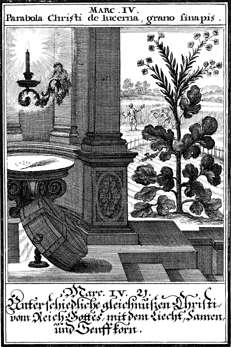


_-_James_Tissot_-_overall.jpg)
.jpg)
